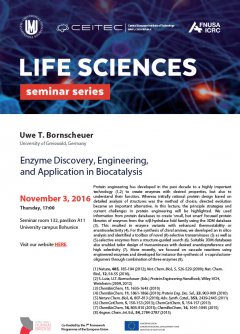Protein engineering has developed in the past decade to a highly important technology (1,2) to create enzymes with desired properties, but also to understand their function. Whereas initially rational protein design based on detailed analysis of structures was the method of choice, directed evolution became an important alternative. In this lecture, the principle strategies and current challenges in protein engineering will be highlighted. We used information from protein databases to create 'small, but smart' focused protein libraries of enzymes from the α/β-hydrolase fold family using the 3DM database (3). This resulted in enzyme variants with enhanced thermostability or enantioselectivity (4). For the synthesis of chiral amines, we developed an in silico analysis and identified a toolbox of novel (R)-selective transaminases (5) as well as (S)-selective enzymes from a structure-guided search (6). Suitable 3DM databases also enabled tailor design of transaminases with desired enantiopreference and high selectivity (7). More recently, we focused on cascade reactions using engineered enzymes and developed for instance the synthesis of ε-caprolactone-oligomers through combination of three enzymes (8).
[1] Nature, 485, 185-194 (2012); Nat. Chem. Biol., 5, 526-529 (2009); Nat. Chem. Biol., 12, 54-55 (2016).
[2] S. Lutz, U.T. Bornscheuer (Eds.) Protein Engineering Handbook, Wiley-VCH, Weinheim (2009, 2012)
[3] ChemBioChem, 11, 1635-1643 (2010)
[4] ChemBioChem, 11, 1861-1866 (2010); Protein Eng. Des. Sel., 23, 903-909 (2010)
[5] Nature Chem. Biol., 6, 807-813 (2010); Adv. Synth. Catal., 353, 2439-2445 (2011)
[6] ChemCatChem, 5, 150-153 (2013); ChemCatChem, 5, 154-157 (2013)
[7] ChemBioChem, 16, 805-810 (2015); ChemBioChem, 16, 1041-1045 (2015)
[8] Angew. Chem. Int. Ed., 54, 2784-2787 (2015)








